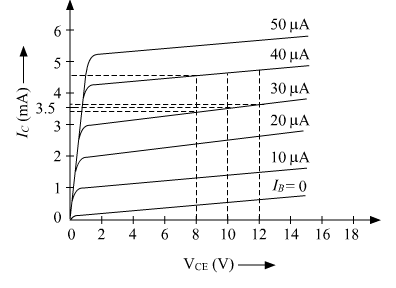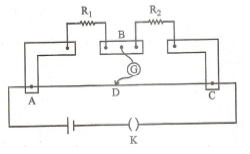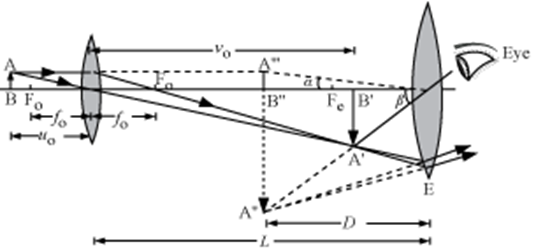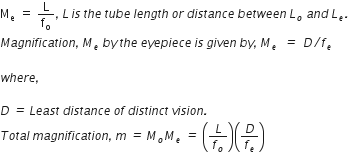 Short Answer Type
Short Answer Typea) In a typical nuclear reaction, e.g. , 
Although number of nucleons is conserved, yet energy is released. How? Explain.
b) Show that nuclear density in a given nucleus is independent of mass number A.(a) Why photoelectric effect cannot be explained on the basis of wave nature of light? Give reasons.
(b) Write the basis features of photon picture of electromagnetic radiation on which Einstein’s photoelectric equation is based.Output characteristics of an n-p-n transistor in CE configuration is shown in the figure. Determine:
(a) Dynamic output resistance
(b) DC current gain and
(c) AC current gain at an operating point VCE=10V, when IB=30 A.
A. 
Using Bohr’s postulates, obtain the expression for the total energy of the electron in the stationary states of the hydrogen atom. Hence draw the energy level diagram showing how the line spectra corresponding to Balmer series occur due to transition between energy levels.
(a) In what way is diffraction from each slit related to the interference pattern in a double slit experiment?
(b) Two wavelength of sodium light 590 nm and 596 nm are used, in turn, to study the diffraction taking place at a single slit of aperture 2 x 10-4 m. The distance between the slit and the screen is 1.5.m. Calculate the separation between the positions of the first maxima of the diffraction pattern obtained in the two cases. Long Answer Type
Long Answer TypeWhile travelling back to his residence in the car, Dr. Pathak was caught up in a thunderstorm. It became very dark. He stopped driving the car and waited for thunderstorm to stop. Suddenly he noticed a child walking alone on the road. He asked the boy at his residence. The boy insisted that Dr. Pathak should meet his parents. The parents expressed their gratitude to Dr. Pathak for his concern for safety of the child.
Answer the following questions based on the above information:
(a) Why is it safer to sit inside a car during a thunderstorm?
(b) Which two values are displayed by Dr. Pathak in his actions?
(c) Which values are reflected in parents’ response to Dr. Pathak?
(d) Give an example of a similar action on your part in the past from everyday life.
(a) State the working principle of a potentiometer. With the help of the circuit diagram; explain how a potentiometer is used to compare the emf’s of two primary cells. Obtain the required expression used for comparing the emf’s.
(b) Write two possible causes for one sided deflection in a potentiometer experiment.
OR
(a) State Kirchhoff’s rules for an electric network. Using Kirchhoff’s rules, obtain the balance condition in terms of the resistances of four arms of Wheatstone bridge.
(b) In the meter bridge experimental set up, shown in the figure, the null point ’D’ is obtained at a distance of 40 cm from end A of the meter bridge wire. If a resistance of 10W is connected in series with R1, null point is obtained at AD=60 cm. Calculated the values of R1 and R2.
(a) Derive the expression for the torque on a rectangular current carrying loop suspended in a uniform magnetic field.
(b) A proton and a deuteron having equal momenta enter in a region of uniform magnetic field at right angle to the direction of the field. Depict their trajectories in the field.
OR
(a) A small compass needle of magnetic moment ‘m’ is free to turn about an axis perpendicular to the direction of uniform magnetic field ‘B’. The moment of inertia of the needle about the axis is ‘I’. The needle is slightly disturbed from its stable position and then released. Prove that it executes simple harmonic motion. Hence deduce the expression for its time period.
(b) A compass needle, free to turn in a vertical plane orients itself with its axis vertical at a certain place on the earth.
Find out the values of
(i) horizontal component of earth’s magnetic field and
(ii) angle of dip at the place.
(a) Draw a ray diagram showing the image formation by a compound microscope.
Hence obtain expression for total magnification when the image is formed at infinity.
(b) Distinguish between myopia and hypermetropia. Show diagrammatically how these defects can be corrected.
OR
State Huygens principle. Using this principle draw a diagram to show how a plane wave front incident at the interface of the two media gets refracted when it propagates from a rarer to a denser medium. Hence verify Snell’s law of refraction.
(b) When monochromatic light travels from a rarer to a denser medium, explain the following, giving reasons:
(i) Is the frequency of reflected and reflected light same as the frequency of incident light?
(ii) Does the decrease in speed imply a reduction in the energy carried by light wave?a) The fig. below shows the formation of image by a compound microscope.
If the object AB is very close to the focus of the objective lens of focal length fo, then magnification Mo by the objective lens is given by, 
b) Difference between myopia and hypermetropia,
|
Myopia |
Hypermetropia |
|
1. The eye ball is shortened |
| 2. Person cannot see distant objects clearly. |
2. Person cannot see near objects clearly. |
A concave lens is used for the correction of myopic eye.
Hypermetropia is corrected using a convex lens.
OR
a) Law of Reflection: Let XY is a reflecting surface at which a wavefront is being incident obliquely. Let v be the speed of the wavefront and at time t = 0, the wavefront touches the surface XY at A. After time t, the point B of wavefront reaches the point B¢ of the surface. According to Huygens principle each point of wavefront acts as a source of secondary waves. When the point A of wavefront strikes the reflecting surface, then due to presence of reflecting surface, it cannot advance further; but the secondary wavelet originating from point A begins to spread in all directions in the first medium with speed v. As the wavefront AB advances further, its points A1, A2, A3… etc. strike the reflecting surface successively and send spherical secondary wavelets in the first medium.

First of all the secondary wavelet starts from point A and traverses distance AA’ (= vt) in first medium in time t. In the same time t, the point B of wavefront, after travelling a distance BB’, reaches point B’ (of the surface), from where the secondary wavelet now starts. Now taking A as centre we draw a spherical arc of radius AA’ (= vt) and draw tangent A’B’ on this arc from point B’. As the incident wavefront AB advances, the secondary wavelets starting from points between A and B’, one after the other and will touch A’B’ simultaneously. According to Huygens principle wavefront A’B’ represents the new position of AB, i.e., A’B’ is the reflected wavefront corresponding to incident wavefront AB.
Now, in right-angled ABB’ and AA’B’

i.e., incident wavefront AB and reflected wavefront A¢ B¢ make equal angles with the reflecting surface XY. As the rays are always normal to the wavefront, therefore the incident and the reflected rays make equal angles with the normal drawn on the surface XY.
i.e., angle of incidence i = angle of reflection r
This is the second law of reflection.
b) (i) If the radiation of certain frequency interact with the atoms/molecules of the matter, they start to vibrate with the same frequency under forced oscillations.
Thus, the frequency of the scattered light (under reflection and refraction) equals to the frequency of incident radiation.
(ii) No, energy carried by the wave depends on the amplitude of the wave, but not on the speed of the wave.
